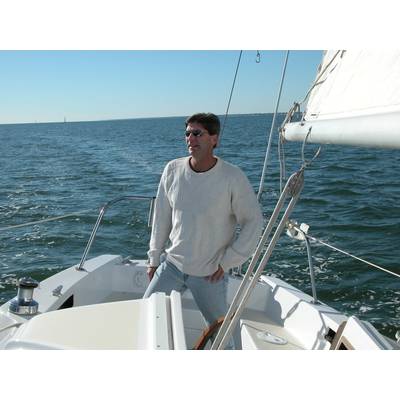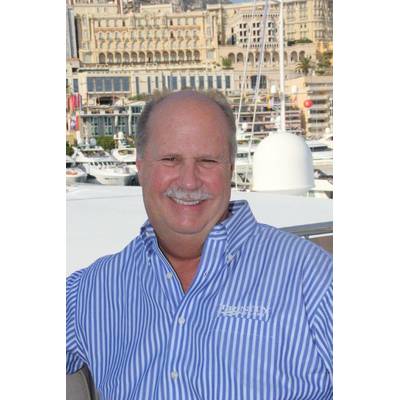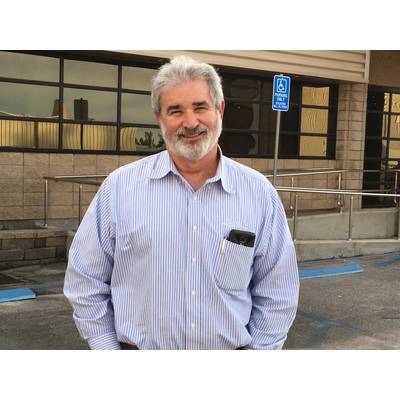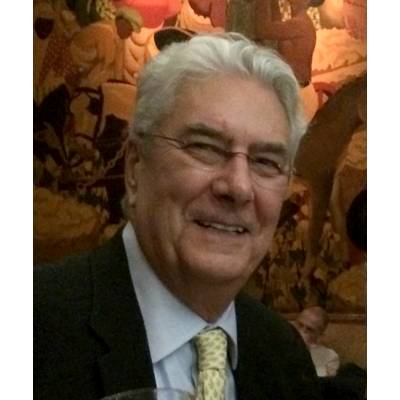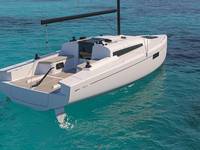Whirlwind of change: Where’s Trinity Yachts' crew today?
Four key players of the disbanded Trinity Yachts, once the world’s sixth largest custom yacht builder, are working in new roles in yachting since the company’s break-up about four years ago.
Billy Smith, Geoffrey van Aller, Jim Berulis and Phil Nuss rolled with the punches, just as they did when this author interviewed them at Trinity’s Cinco de Mayo crayfish boil celebrating their new Gulfport facility in Mississippi in May, 2006.
In a region suffering after Hurricane Katrina toppled the Gulf Coast and sank New Orleans on August 29, 2005, Trinity Yachts emerged from ground zero as a bonafide case study in successful crisis management, bouncing back from a catastrophic event that crippled and closed thousands of businesses to become an unstoppable, boat-building boomtown with 24 yachts on order in 2008.
The devastating hurricane spearheaded Trinity’s revolutionary growth. Becoming America’s largest yacht manufacturer, the shipyard had capacity to deliver eight to 10 megayachts annually, under 19 acres of covered workspace at two facilities. Trinity built steel and aluminum yachts in the new Gulfport headquarters, with the reopened New Orleans yard building aluminum hulls and decks supporting Gulfport.
Just two months after Hurricane Katrina, Trinity’s presentation at the 2005 Ft. Lauderdale International Boat Show (FLIBS) made the yachting world stand up and take notice. Extraordinary measures during the hurricane kept yachts safe for delivery and their FLIBS debut. The invincible Zoom, Zoom, Zoom, Mustang Sally, Big Easy and Mia Elise, the largest steel hull motoryacht built in the United States in 50 years, were an impressive lineup for any builder at FLIBS, and remarkable for one which endured the worst natural disaster in history.
Prior to the recession of 2008, the strong Euro made American-built megayachts more affordable to European-built boats and Trinity Yachts triumphed in a whirlwind of change. The company was among New Orleans’ largest manufacturing employers, with over 500 employees at Trinity’s 38-acre waterfront property on the Industrial Canal in the heart of New Orleans.
That kind of grit built the New Orleans property, which began operation as shipyard in 1941 as Higgins Industries. The American icon employed 20,000 workers producing the amphibious landing craft that won D-Day in World War II. Shallow, stump jumpers designed to work in the swamp with a protected propeller inspired the landing craft which gave New Orleans a war effort industry during the world’s darkest days. Gulf boats with shallow drafts are called hard chine hulls for simplicity, an easy build and a generally lower cost.
“Building 150-foot yachts that draw seven feet running 20 knots is a direct result of making crew boats to run in the Gulf of Mexico’s shallow waters, making Trinity’s yachts ideal for the Bahamas,” said Billy Smith, then Trinity’s vice president.
John Dane III became president of Trinity Marine Group in 1987 and approached Smith in 1988, encouraging the company’s diversification. Trinity Yachts was spun out of Trinity Industries and Halter Marine as the market for work vessels changed.
Smith had been around yachts all his life and was ready to build them. “We kept getting calls from guys in Lauderdale, the big yachts of the era, 86-foot Burgers and Browards.”
Smith wasn’t impressed with the construction of early aluminum yachts, which were not classed, initially. “In the late 80s, the majority of 100-foot boats in Fort Lauderdale had no watertight bulkheads,” said Smith. “Some would go out to sea and blow out portholes. We just weren’t used to building boats like that.”
Trinity had an excellent run for about 20 years and delivered 62 hulls, but the new yacht construction ceased in 2016 after being purchased by Harvey Gulf. Yachting Journal recently caught up with four key players in new roles in the marine industry.
Billy Smith
Director of Key Accounts, Metal Shark and Yacht Broker, Merle Wood & Associates.
Billy Smith, Trinity’s executive vice president, grew up on the Mississippi River with his family’s business of derricks, barges, and tugs, and enjoyed sailing on Lake Pontchartrain and sportfishing in Louisiana’s sportsman’s paradise.
Smith looked relaxed on a cold January day in Metairie, La. He’s “having fun working.”
“I like it,” said Smith. “The whole vibe is exciting. Metal Shark is an up and coming shipyard. This is a millennial company with some virtual offices. I am based in Mississippi and am focused on Metal Shark’s Alabama facility in the old Horizon yard.”
Smith also has a nice office at Merle Wood in Fort Lauderdale, showing the biggest brokerage vessels in the superyacht world to his impressive network, a lifetime of connections. He reflected, “to build a $30 or $40 million superyacht, your client should have at least $200 - $300 million net worth.”
However, an upbeat, charismatic Smith still has his feet firmly on the ground. He remembers what it was like to live in a prehistoric age after Katrina, with no electricity or cell phones, each day was a struggle.
“After the storm, it was like living 100 years ago,” he said. “We had to communicate face-to-face and leave notes. It made me aware that we all came into this world with nothing. And we’ll leave with nothing. What counts is what we do every day in-between. We appreciate what we have today.”
Smith is proud of what Trinity accomplished on its tremendous run. He said that under the right circumstances, he believes nearly all employees would all return to build more Trinity yachts, all these years later. Not that he actually sees it happening, though.
“I’m shocked we couldn’t find a buyer for Trinity,” he said, adding, “we could have been reopened. It would be turnkey with the right operators, not a startup - but a restart. The labor has not left the area.”
Geoffrey van Aller - President, van Aller Yacht & Naval Design
Mary P, Lady Linda and Mustang Sally aren’t designated names for Hurricane Season 2019. They’re three of many superyachts conceived by Trinity Yachts' chief yacht designer and naval architect, Geoffrey van Aller.
A graduate from the University of New Orleans school of marine engineering and naval architecture, van Aller, now 54, pumped out about 60 now iconic megayachts in 20 years that built Trinity’s successful brand as the world’s sixth largest custom yacht builder.
Looking at his designs all these years later, van Aller’s exterior styling is still sleek and timeless. It’s difficult to tell which decade - or millennium - his nautical creations were actually launched.
van Aller’s designs are traditional, elegant and robust, producing Trinity’s beautiful superyacht fleet with flowing lines that look good from every angle.
“Geoff has a good eye and only draws what can actually be built, from a structural standpoint,” said Billy Smith.
“I like to design the whole boat as one whole, piecing details together,” said van Aller. “I don’t like the cluttered look of a mish-mash of too much detail. I’d rather see the flowing shapes and curves speak for themselves than straight lines with slab sides - and a myriad of costume jewelry thrown in.”
As a child, van Aller was intrigued with the short voyage to Horn Island in the Mississippi Sound. The experience of camping and fishing there, and marveling at 50-foot sportfishers docked at Biloxi’s Broadwater Beach Marina in the 1960s, set van Aller on a journey of nautical discovery that never ended.
“Those were the biggest boats I’d ever seen,” van Aller says of the humdingers at Broadwater in Biloxi, Miss. “It whet my appetite for yachts for sure.”
Now based in Ocean Springs, Miss. with his own design firm, van Aller Yacht and Naval Design, Geoff van Aller is busy with new superyacht designs and refits and refit and conversion work for commercial builders.
Even after losing all three of his family homes in Katrina, van Aller once lived in one of the Trinity trailers for five months, he still can’t imagine himself anywhere but Mississippi, where he is remodeling a classic home in his spare time, another creative outlet.
“I grew up here,” he said. “All you ever hear about is Florida and the Northwest...people used to not think of the South as a place to design or build megayachts, but they know us now. You travel the world wondering where you’re going to land to design and build megayachts and wind up doing it in your own backyard. That’s pretty neat.”
Jim Berulis - Vice President and General Manager, Savannah Yacht Center
It seems as though Jim Berulis, 72, is always building something from scratch with his own hands. A no-nonsense, straight-shooter, Trinity’s vice president learned patience and strategy the hard way, building boats by day and repairing homes by night and weekends after Katrina. The hurricane had taken its toll on his employees, stress initiated divorces.
“Everyone suffered,” said Berulis. “Everyone knows someone who lost everything.”
His leadership skills during Trinity’s crisis now benefit Savannah Yacht Center’s expansion. As general manager, Berulis reflected upon his first day in Savannah about three years ago, where he was all alone in the yard, by himself.
“It was eerie, the silence,” said Berulis. “But I envisioned the possibilities.”
Six superyachts chose Savannah Yacht Center and its 17,000T drydock for their refit and service work since Berulis assumed command. As one section of the yard services and maintains vessels, Berulis and his team simultaneously refit the shipyard’s infrastructure for strategic growth and capital improvements catering to superyachts 60-meters and over. Completion of all heavy construction is expected during 2019.
With a 140-meter graving dock for yachts up to 450-feet in length and 1,200-feet of wet slips, Savannah Yacht Center’s new 3,240T synchrolift and rail transfer system will simultaneously accommodate over six, 260-foot superyachts, on the hard for refits and service.
Strategically located in the United States near the Atlantic Ocean in Georgia, Savannah’s pleasant climate allows refit work 12 months a year. The renovated yard will feature every amenity, including a ship’s store and market, offices, gymnasium, crew lounge, cafe and bar, with the new facilities appearing nearly complete during this author’s tour of the yard in September.
Berulis is enjoying the culinary delights in Savannah, which compare to New Orleans, but in smaller supply.
“After about 90 days, you have to start over with a new restaurant in Savannah, because you’ve hit all the best ones,” he joked. “They are excellent and I have my favorites, but my wife and I know what it is like to miss New Orleans.”
Phil Nuss - President, Trinity Yacht Repair
The former chief of engineering for Trinity Yachts, Phil Nuss, 54, is still on Seaway Road at Trinity Yacht Repair, now part of Gulf Coast Shipyard Group.
“We made our debut at FLIBS 2018 after deciding to get back in business in June or July,” said Nuss.
“We spend most of our time maintaining Harvey Gulf fleet," he said. "We are doing some small repair projects and trying to target bigger jobs. We can handle up to 100-meter boats and pick up 3000T boats all the time.”
Trinity Yacht Repair is available for repairs and maintenance on any superyacht, although Nuss has innate knowledge of every Trinity yacht ever built. He still uses the Trinity logo for Trinity Yacht Repair.
Nuss claims a yacht captain can save 10-percent on a refit or repair job with Trinity Yacht Repair, even after the fuel burn from Fort Lauderdale to Gulfport.
“We are also doing class inspections. We will save you money and are an hour from New Orleans. I commute from Mandeville to Gulfport every day. It isn’t far."




